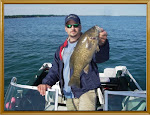
If you were to ask me what my favorite bass bite was I'd answer you without hesitation..."The worm bite"! You can take my spinnerbaits, cranks, swimbaits, top water (well, maybe not my topwaters) but as long as you give me my worms, I'll find the fish! There is something about the concentration involved with fishing a worm on a Texas rig that I just can't stay away from. The cast, followed by an anticipated sink to the bottom, slowly raising your rod, only to immediately feel that "THUNK"! Quickly reeling in the slack as you drop your rod....BAM!! Fish on! God I LOVE worm fishing. But don't be fooled by this simple looking bait because it, too, has it's list of does and dont's! Now, like everything else involving bass, there are exceptions (or opinions) to every rule, but I wanted to break down the true fundamentals of worm fishing. First things first...The Worm!
What in the hell is this really suppose to be? I mean, come on! I haven't' spent a whole lot of time swimming on the bottom of my favorite lake, but I would like to think there aren't too many night crawlers swimming around down there. Now I'm sure some get caught in the current or maybe washed in from a heavy rain, but literally swim? Well, I'm not a biologist so I'm not going to pretend I know what the heck I'm talking about, but I do know that bass just can't resist them. Best bait in your bag, hands down!
Like all lure choices, colors play an important role. In fact, I believe it plays a much larger role than in most baits. If worked properly, a bass really is allowed to take it's time and process a lot of information about what it's about to eat. So I really believe color is extremely important. If fishing a dark water lake, or muddy lake I like to go with your brighter colors like chartreuse, bright purples. In the clearer waters like we have in PA, I like to throw the darker colors like deep purples, deep reds, and motor oil. But my favorite and one I fish 95% of the time is purple. But this is really not any different than any lure so experiment with different colors until you find one that works well on your lake. Just don't get reeled in to the marketing BS. You don't need every color made in worms or any lure for that matter. Break it down to three choices of primary shades. Darks, Mediums, and naturals.
There are a few different ways in rigging a worm and most have there uses, but I rig my worms Texas style. It's a very simple rig that involves a bullet weight, worm hook, and of coarse, your worm. As far as weight goes, that depends on how deep you're fishing. For instance, if you're fishing a 20 foot drop off you may want to go with a 1/2 oz and on a really windy day, you may want to go with a 3/4 oz weight. Your objective is to just have enough weight to be able to effectively stay in contact with the bait. The lighter the better, in my opinion. So if you're fishing a shallow flat during the spawn, you won't need the heavy stuff and will be fine with just a 1/8 oz weight. The important part is getting your bait to the bottom, but allowing it to sink slowly as you drop your rod.
I really like to use Berkley Powerworms. I have personally witnessed the difference in these baits and believe that the sent not only draws more bites, but also affords you additional time to set the hook. They really do seem to hold on to the bait a lot longer. As far as hooks are concerned, I like a really wide gap hook for worm fishing. There are litterly tons of different types of worm hooks so this can get really confusing. I prefer a 2/0 hook for Texas Rigging. If you'd like to know how to rig a Texas rig click HERE.
There are two main problems I see when people are just getting into worm fishing. First is bait contact. What I mean by contact, is always staying connected with the bait. Never and I mean never let too much slack in your line. Cast it out and just let it sink to the bottom. Making sure that there is no slack in you line. Bass will hit a worm bait on the fall 75% of the time.
 And if you have too much slack in that line, than you'll never know they hit it. With hard baits that require a constant retrieve you'll know when a fish strikes, but not so much with worm fishing. This is what I really enjoy about it. Once that bait hits the water my eyes never look away. I'm always watching the line and the water around it. Sometimes a fish will take it in and start swimming either toward you or to the side. Even though you won't feel the fish, you'll most likely see your line move in that direction. So, always make sure you can feel that lure, and always pay attention to that line.
And if you have too much slack in that line, than you'll never know they hit it. With hard baits that require a constant retrieve you'll know when a fish strikes, but not so much with worm fishing. This is what I really enjoy about it. Once that bait hits the water my eyes never look away. I'm always watching the line and the water around it. Sometimes a fish will take it in and start swimming either toward you or to the side. Even though you won't feel the fish, you'll most likely see your line move in that direction. So, always make sure you can feel that lure, and always pay attention to that line. The second mistake I see people doing wrong is working the bait way too fast. Once that bait hits the water let it get to the bottom. Once it reaches the bottom, simply let it sit for 30 seconds or so. A lot of times a bass will hear it hit the water, and watch it fall. That fish will move closer to it just to check it out. Even if that fish isn't in the mood to eat it will stay there just watching the worm. As soon as you start to lift the rod, that fish will strike it out of pure instinct. Cast it out and let it sit than slowly...let me repeat, SLOWLY raise your rod. Than let the bait fall again to the bottom. Repeat this process all the way back to the boat. Once a fish hits it, always reel down on the fish, giving them a few seconds before setting the hook. You'll be surprised how long they will hold onto it. I hope this helps those who are just starting out. If you have some more questions, don't hesitate sending me an email. I'm far from being a pro, but I've been worm fishing since I was a kid!













No comments:
Post a Comment